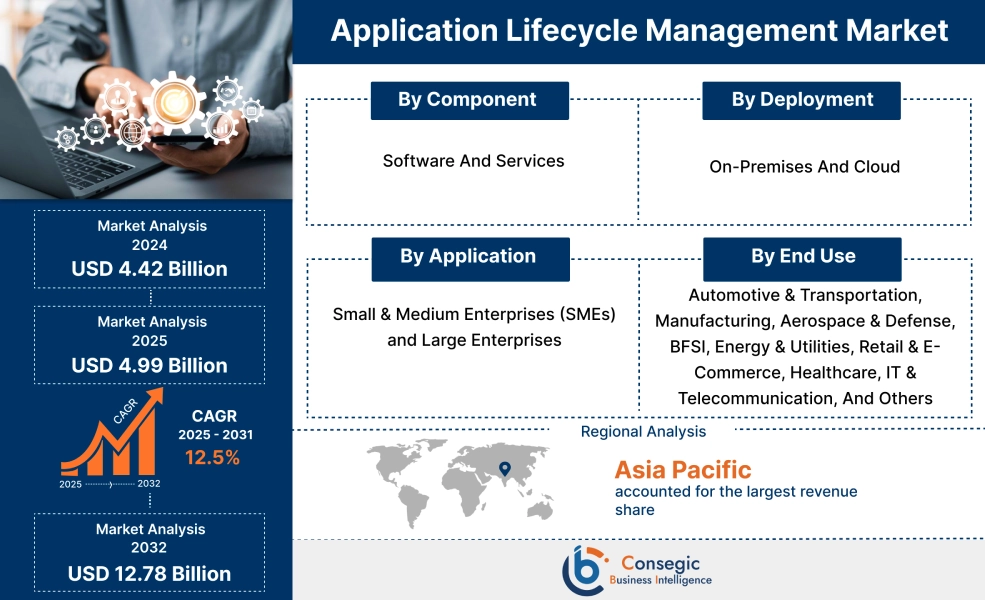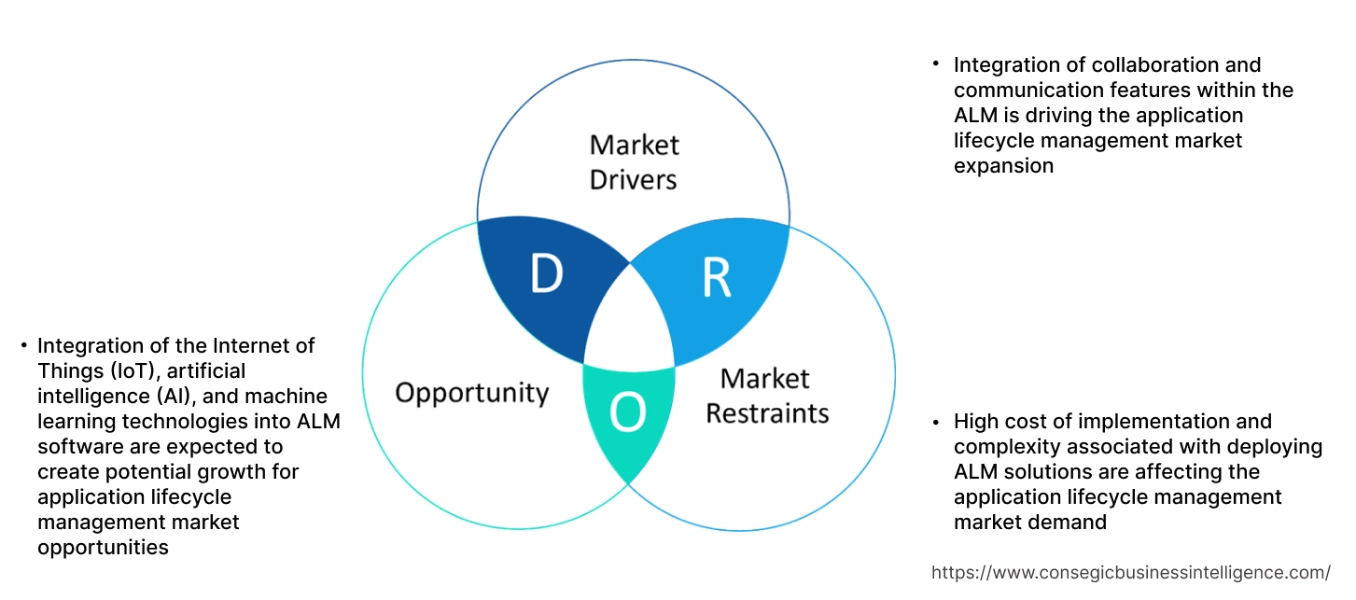Application Lifecycle Management Market Size:
Application Lifecycle Management Market Size is estimated to reach over USD 12.78 Billion by 2032 from a value of USD 4.42 Billion in 2024 and is projected to grow by USD 4.99 Billion in 2025, growing at a CAGR of 12.5% from 2025 to 2032.
Application Lifecycle Management Market Scope & Overview:
Application lifecycle management (ALM) encompasses the entire life cycle of an application, from its initial conception to its eventual retirement. It involves managing all phases, including requirements management, software architecture, development, testing, maintenance, change management, deployment, and release. The ALM tools provide a unified platform for managing requirements, design, development, testing, and deployment, significantly enhancing productivity and reducing time-to-market for new applications.
Application Lifecycle Management Market Dynamics - (DRO) :
Key Drivers:
Integration of collaboration and communication features within the ALM is driving the application lifecycle management market expansion
Collaboration and communication functionalities embedded within PLM platforms facilitate seamless interaction and information exchange among cross-functional teams, suppliers, partners, and even customers throughout every stage of the product lifecycle. By providing a centralized platform for sharing ideas, feedback, and insights, PLM solutions foster collaboration across dispersed teams, enabling them to work cohesively towards common goals and objectives. This collaborative approach not only enhances the quality and innovation of product designs but also accelerates the design process, reducing time-to-market and increasing agility in responding to changing market demands.
- For instance, in February 2023, Siemens announced the partnership with IBM, to accelerate the creation of environmentally friendly products and business practices, by developing software solutions for engineering, asset management, and service lifecycle management. The companies have developed a unified software platform, which will link diverse engineering fields, such as mechanics, electronics, and software, enabling better tracking and more sustainable product lifecycles.s
Thus, according to the application lifecycle management market analysis, the integration of collaboration and communication features within the ALM is driving the application lifecycle management market size.
Key Restraints:
High cost of implementation and complexity associated with deploying ALM solutions are affecting the application lifecycle management market demand
Organizations, particularly small & medium-sized enterprises (SMEs), often face budget constraints and limited resources, making it challenging to invest in comprehensive ALM tools. Additionally, the complexity of integrating ALM solutions with existing workflows and the need for ongoing support and maintenance can limit some organizations from adopting these tools. Furthermore, concerns about data security and privacy continue to be a significant barrier, especially for organizations in highly regulated industries. Thus, the aforementioned factors would further impact the application lifecycle management market size.
Future Opportunities :
Integration of the Internet of Things (IoT), artificial intelligence (AI), and machine learning technologies into ALM software are expected to create potential growth for application lifecycle management market opportunities
These advanced technologies enable predictive analytics, automated testing, and real-time insights, enhancing the capabilities of ALM tools and allowing organizations to make more informed decisions throughout the software development lifecycle. As AI and ML technologies continue to evolve, their integration into ALM solutions is expected to drive further growth, enabling more efficient and effective software development practices. Vendors that invest in AI-driven features and functionalities are likely to gain a competitive edge, attracting organizations seeking to leverage the latest technological advancements.
- For instance, in April 2024, IBM announced the acquisition of HashiCorp, an American software company specializing in multi-cloud infrastructure automation, for USD 6.4 billion. This strategic move is designed to integrate HashiCorp's capabilities with IBM's existing hybrid cloud and AI solutions. The goal is to enhance IBM's application lifecycle management, allowing the company to offer more comprehensive and streamlined infrastructure and application management across various hybrid and multi-cloud environments.
Thus, based on the above application lifecycle management market analysis, the integration of the Internet of Things (IoT), artificial intelligence (AI), and machine learning technologies into ALM software is expected to drive the application lifecycle management market opportunities.
Application Lifecycle Management Market Segmental Analysis :
By Component:
Based on component, the market is segmented into software and services.
Trends in the Component:
- As businesses continue to embrace digital transformation and adopt modern development practices, the demand for advanced ALM tools and services is expected to remain strong.
- The integration of AI and ML with ALM solutions is expected to further revolutionize the software development lifecycle, making it more efficient and intelligent.
- Thus, based on the above analysis, these factors are driving the application lifecycle management market demand and opportunities.
The software segment accounted for the largest revenue share in the year 2024.
- The software segment is expected to hold the largest market share, driven by the increasing demand for comprehensive ALM tools that offer end-to-end lifecycle management capabilities.
- The continuous evolution of ALM software to include advanced features such as real-time collaboration, version control, and automated testing further boosts the adoption of ALM software across various industries.
- For instance, in January 2024, Siemens announced the partnership with Salesforce, to deploy the Teamcenter SLM application on Salesforce AppExchange. This application merges with Siemens' product lifecycle management (PLM) technology with Salesforce's service and manufacturing Clouds. The aim is to empower businesses to adopt more service-centric models by streamlining and enhancing their service lifecycle management.
- Thus, based on the above analysis, these factors are further driving the application lifecycle management market growth.
The service segment is anticipated to register the fastest CAGR during the forecast period.
- The segment growth can be attributed to the rising need for consulting, implementation, and support services associated with ALM solutions.
- The increasing complexity of software applications necessitates ongoing support and maintenance services to ensure optimal performance and compliance with evolving industry standards.
- The shift towards managed services and the growing trend of outsourcing ALM-related activities also contribute to the development of the services segment.
- Thus, based on the above analysis, these developments are expected to drive the application lifecycle management market share during the forecast period.
By Deployment:
Based on the deployment, the market is segmented into on-premises and cloud.
Trends in the deployment:
- The ability to leverage AI and ML in a cloud environment further enhances the efficiency and intelligence of the software development lifecycle, making cloud-based ALM solutions an attractive option for business organizations.
- The growing trend of remote work and the need for agile and responsive development processes are also contributing to the adoption of cloud-based and on-premises ALM solutions.
The on-premises segment accounted for the largest revenue share in the year 2024.
- The on-premises segment has traditionally been the preferred choice for organizations that require complete control over their ALM environment.
- This deployment mode offers several advantages, including enhanced security, customization, and compliance with stringent regulatory requirements.
- Organizations in highly regulated industries, such as finance and healthcare, often opt for on-premises ALM solutions to ensure data privacy and adherence to industry standards.
- Thus, based on the above analysis, these factors would further supplement the application lifecycle management market
The cloud segment is anticipated to register the fastest CAGR during the forecast period.
- The cloud deployment mode is anticipated to experience significant growth during the forecast period, driven by the increasing adoption of cloud computing technologies and the growing need for flexible and scalable ALM solutions.
- Cloud-based ALM tools offer several benefits, including reduced upfront costs, ease of deployment, and the ability to access ALM functionalities from anywhere.
- These solutions enable organizations to quickly scale their ALM environment to accommodate changing business needs, which are ideal options for businesses of all ranges.
- The cloud-based ALM tools facilitate seamless collaboration among distributed teams, enhancing productivity, and efficiency.
- Thus, the above factors would further supplement the application lifecycle management market during the forecast period.
By Enterprise Size:
Based on enterprise size, the market is segmented into small & medium enterprises (SMEs) and large enterprises.
Trends in the enterprise size:
- By adopting advanced ALM solutions, small and large enterprises can effectively manage the complexities of modern software development, driving innovation and maintaining a competitive edge in the market.
- The ability to quickly iterate and release new features and updates is crucial for these organizations, and ALM tools provide the necessary infrastructure to support continuous development and delivery.
The large enterprises segment accounted for the largest revenue in the year 2024.
- Large enterprises require more strong and comprehensive ALM solutions capable of managing complex and large-scale software development projects.
- These organizations often face complex regulatory and compliance requirements, necessitating ALM tools with advanced features for tracking, auditing, and reporting.
- The increasing emphasis on digital transformation and the adoption of agile methodologies among large enterprises is further driving the demand for ALM solutions in this segment.
- Thus, based on the above analysis, these factors are driving the application lifecycle management market growth.
The small & medium-sized enterprises (SMEs) segment is anticipated to register the fastest CAGR during the forecast period.
- The SMEs segment is expected to witness significant development during the forecast period, attributed to the increasing awareness of the benefits of ALM solutions and the growing adoption of cloud-based tools.
- SMEs often face unique challenges in managing their software development processes, including limited resources, budget constraints, and the need for rapid innovation.
- ALM solutions provide SMEs with the necessary tools to streamline their development processes, improve collaboration, and enhance the quality of their applications.
- The availability of cost-effective, cloud-based ALM solutions makes it easier for SMEs to adopt these tools, driving the development of the segment.
- These factors are anticipated to further drive the application lifecycle management market trends during the forecast period.
By End Use:
Based on end use, the application lifecycle management market is segmented into automotive & transportation, manufacturing, aerospace & defense, BFSI, energy & utilities, retail & e-commerce, healthcare, IT & telecommunication, and others.
Trends in the end use:
- The increasing focus on customer satisfaction and the need for high-quality applications are expected to drive the demand for ALM solutions in the upcoming years.
- As organizations strive to enhance agility and responsiveness in their software development processes, the need for strong ALM solutions that support continuous integration and delivery is expected to rise. This trend is further accelerated by the ongoing digital transformation initiatives, as businesses seek to modernize their operations and improve customer experiences.
The BFSI segment accounted for the largest revenue share of 18.77% in the year 2024.
- In the BFSI sector, the need for ALM software is fueled by stringent regulatory requirements and the need for high levels of security and compliance throughout the software development lifecycle.
- Financial institutions rely on ALM solutions to ensure that their software applications meet complex compliance standards, avoid potential legal risks, and protect sensitive customer data.
- The integration of advanced features such as automated testing and audit trails allows BFSI organizations to maintain transparency and accountability, essential elements in building trust with clients and regulatory bodies.
- Thus, the aforementioned factors are driving the global market trends.
The IT & telecommunication segment is anticipated to register the fastest CAGR during the forecast period.
- The IT and telecommunication segment is also expected to witness significant development during the forecast period, attributed to the rapid advancements in technology and the increasing need for innovative software solutions.
- The IT and telecommunications sector is characterized by fast-paced innovation and the need for continuous development and delivery of new applications and services.
- Moreover, ALM tools facilitate agile and DevOps practices, enabling organizations in this sector to quickly respond to market changes and customer needs, driving the development of the segment.
- Thus, the above factors are expected to drive the application lifecycle management market trends during the forecast period.
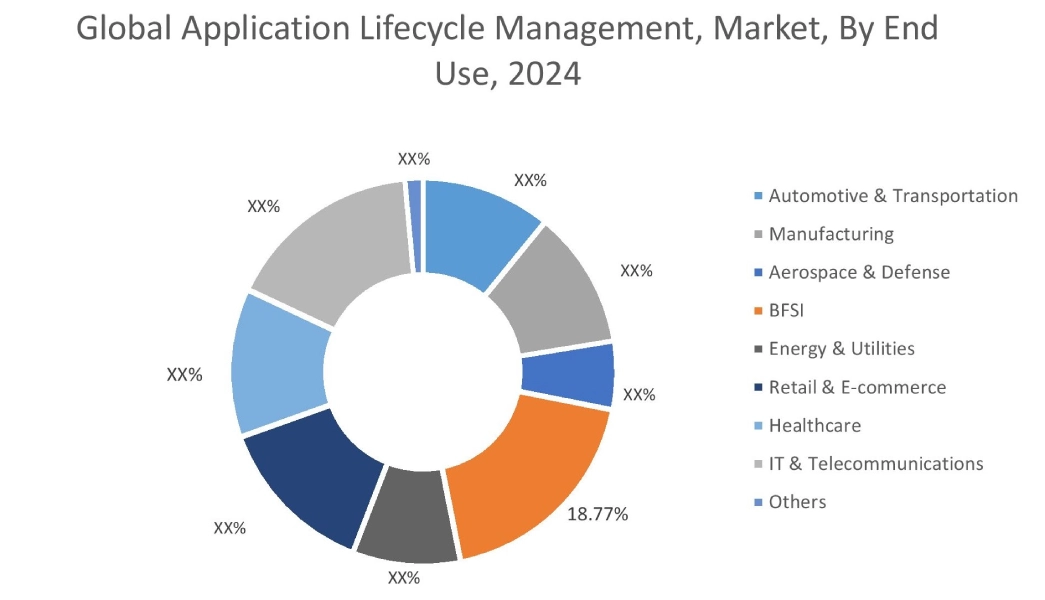
Regional Analysis:
The global market has been classified by region into North America, Europe, Asia-Pacific, Middle East & Africa, and Latin America.
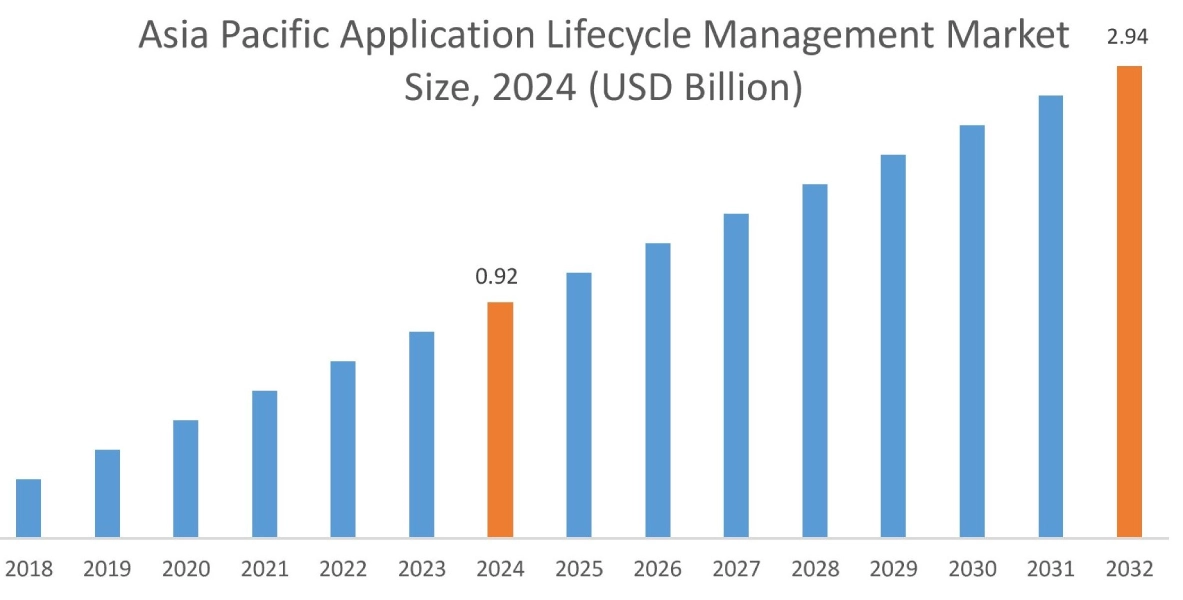
Asia Pacific application lifecycle management market expansion is estimated to reach over USD 2.94 billion by 2032 from a value of USD 0.92 billion in 2024 and is projected to grow by USD 1.05 billion in 2025. Out of this, the China market accounted for the maximum revenue split of 36.81%. The Asia Pacific region is expected to witness the highest growth rate during the forecast period, attributed to rapid industrialization, increasing IT investments, and the growing startup ecosystem in countries like India and China. Further, the region's growing focus on digital transformation and the adoption of modern development practices are driving the need for ALM solutions. Additionally, government initiatives aimed at promoting technology adoption and innovation are likely to further drive market growth in the Asia Pacific region. These factors would further drive the regional application lifecycle management market during the forecast period.
- For instance, in February 2023, Bricsys announced the partnership with ITI Technegroup, a subsidiary of Wipro, to provide integration between Siemens’ Teamcenter software and BricsCAD. This partnership equips BricsCAD users with advanced functionalities that improve their design processes and make product development easier. The integration is anticipated to greatly boost productivity and efficiency in design and engineering by providing top-tier tools to simplify different stages of the design workflow. The above factors are driving the market in the Asia-Pacific region.
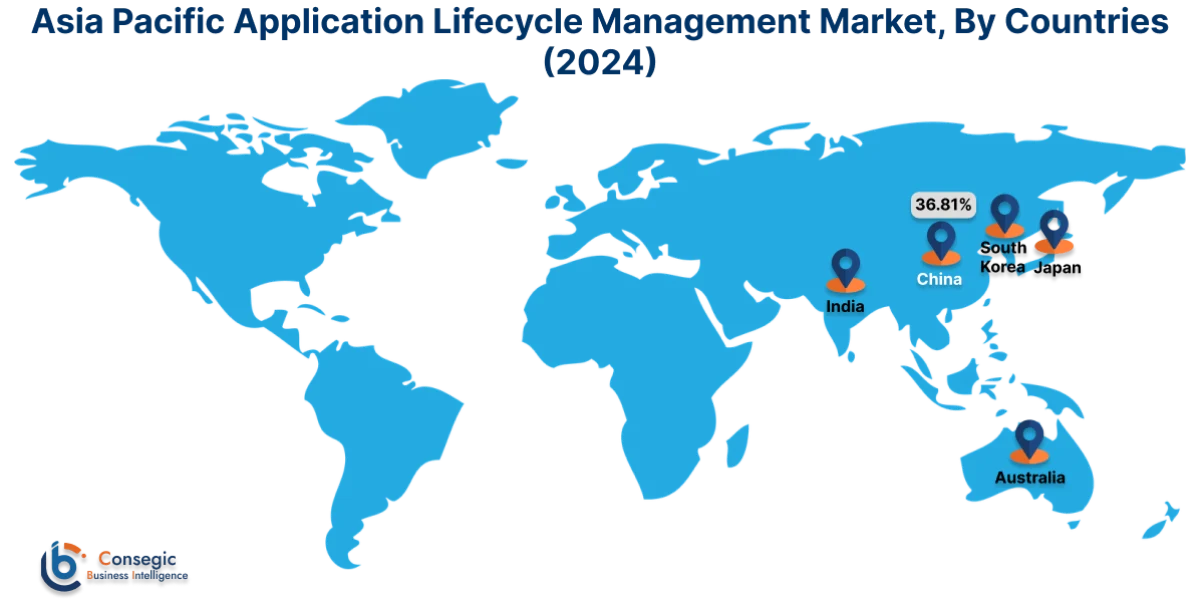
The North American market is estimated to reach over USD 5.15 billion by 2032 from a value of USD 1.79 billion in 2024 and is projected to grow by USD 2.02 billion in 2025. North America holds a dominant position in the market, driven by the presence of major technology companies and a strong emphasis on innovation and digital transformation. Across diverse sectors, such as finance, healthcare, manufacturing, and telecommunications, organizations in the region are focused on efficient software development. This is crucial for them to stay competitive and keep up with ever-changing customer needs for innovation. These factors would further drive the market in North America.
According to the analysis, the application lifecycle management industry in Europe is anticipated to witness significant development during the forecast period. The region's focus on innovation and the increasing adoption of digital health solutions, e-commerce, and financial technologies are driving the need for ALM tools. Additionally, the increasing adoption of cloud-based ALM tools, coupled with a growing emphasis on data security and privacy, is expected to drive the need in the Latin American region. Further, the increasing volume of software development projects in the Middle East & Africa region is driving a strong need for application lifecycle management solutions. These solutions need to be versatile enough to support various development environments, manage complex software lifecycles, and meet the specific needs of both startups and established businesses.
Top Key Players and Market Share Insights:
The global application lifecycle management market is highly competitive with major players providing solutions and services to the national and international markets. Key players are adopting several strategies in research and development (R&D), product innovation, and end-user launches to hold a strong position in the market. Key players in the application lifecycle management industry include-
- Atlassian Corporation (Australia)
- IBM Corporation (U.S.)
- Rocket Software, Inc. (U.S.)
- PTC Inc. (U.S.)
- Parasoft Corporation (U.S.)
- Microsoft Corporation (U.S.)
- Open Text Corporation (Canada)
- Siemens AG (Germany)
- Intland Software GmbH (Germany)
- Perforce Software, Inc. (U.S.)
Recent Industry Developments :
Product Expansion:
- In May 2024, Microsoft Power Platform unveiled the Block unmanaged customizations feature. This update boosts system administrators to restrict direct modifications and prevent the import of unmanaged solutions into production environments. The aim is to ensure that all changes adhere to approved application lifecycle management processes while improving system reliability and auditing.
Application Lifecycle Management Market Report Insights :
| Report Attributes | Report Details |
| Study Timeline | 2019-2032 |
| Market Size in 2032 | USD 12.78 Billion |
| CAGR (2025-2032) | 12.5% |
| By Component |
|
| By Deployment |
|
| By Enterprise Size |
|
| By End Use |
|
| By Region |
|
| Key Players |
|
| North America | U.S. Canada Mexico |
| Europe | U.K. Germany France Spain Italy Russia Benelux Rest of Europe |
| APAC | China South Korea Japan India Australia ASEAN Rest of Asia-Pacific |
| Middle East and Africa | GCC Turkey South Africa Rest of MEA |
| LATAM | Brazil Argentina Chile Rest of LATAM |
| Report Coverage |
|
Key Questions Answered in the Report
How big is the Application Lifecycle Management Market? +
Application Lifecycle Management market size is estimated to reach over USD 12.78 Billion by 2032 from a value of USD 4.42 Billion in 2024 and is projected to grow by USD 4.99 Billion in 2025, growing at a CAGR of 12.5% from 2025 to 2032.
Which is the fastest-growing region in the Application Lifecycle Management Market? +
Asia-Pacific region is experiencing the most rapid growth in the market.
What specific segmentation details are covered in the Application Lifecycle Management report? +
The application lifecycle management report includes specific segmentation details for component, deployment, enterprise size, end use, and region.
Who are the major players in the Application Lifecycle Management Market? +
The key participants in the market are Atlassian Corporation (Australia), IBM Corporation (U.S.), Microsoft Corporation (U.S.), Open Text Corporation (Canada), Siemens AG (Germany), Intland Software GmbH (Germany), Perforce Software, Inc. (U.S.), Rocket Software, Inc. (U.S.), PTC Inc. (U.S.), Parasoft Corporation (U.S.), and others.
